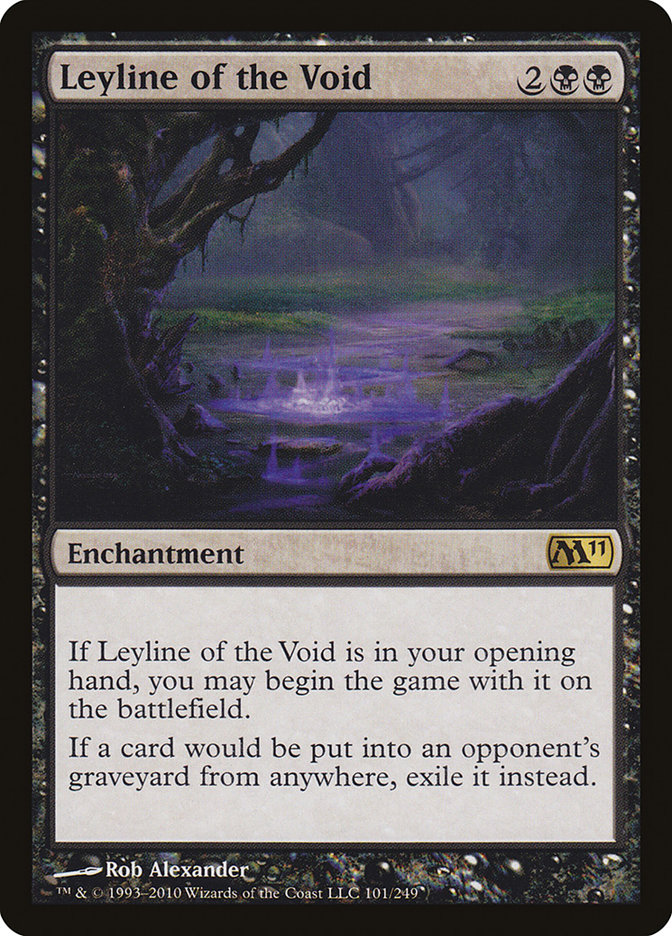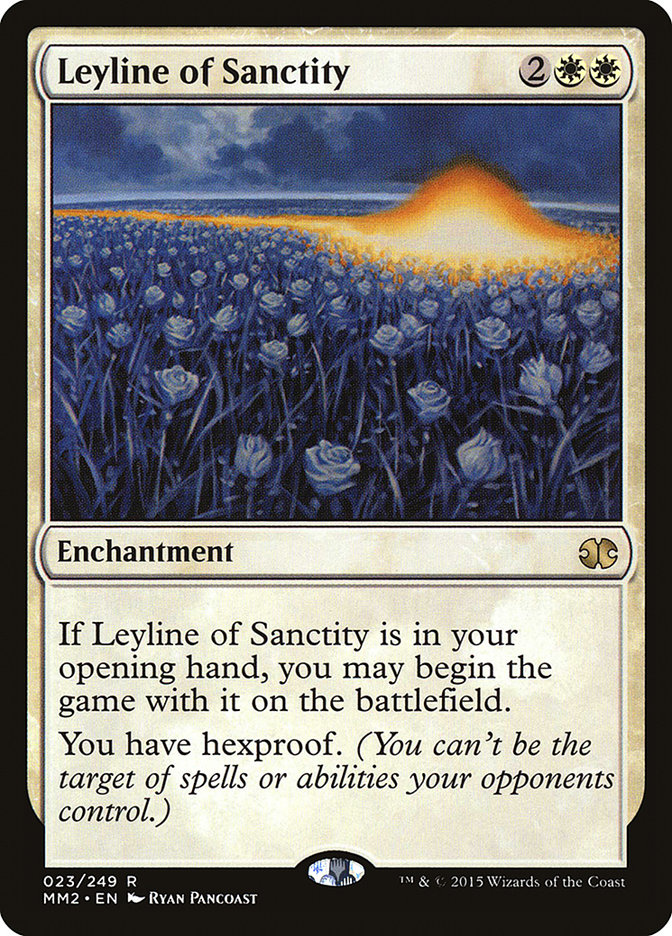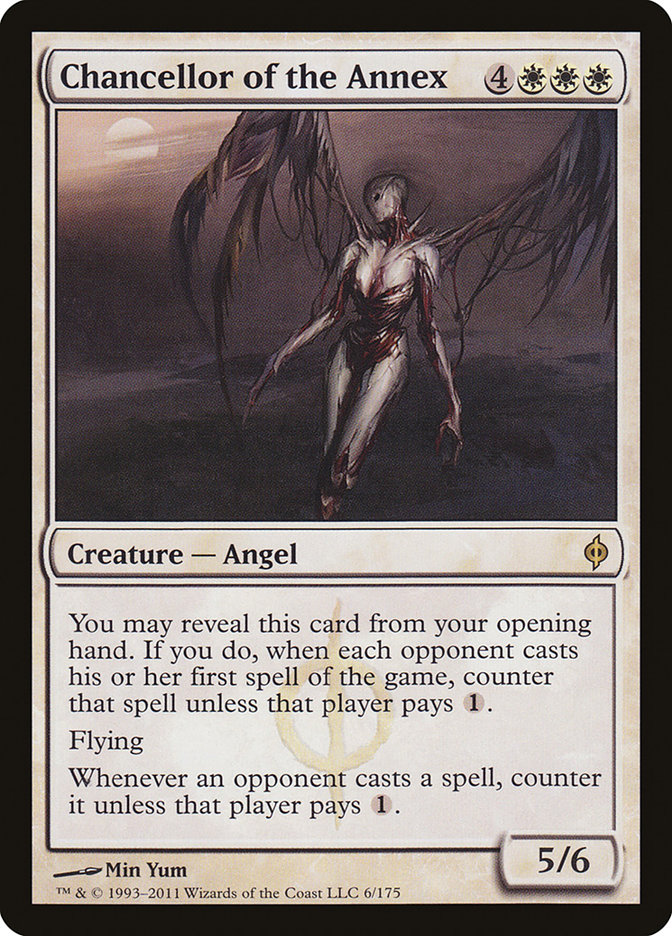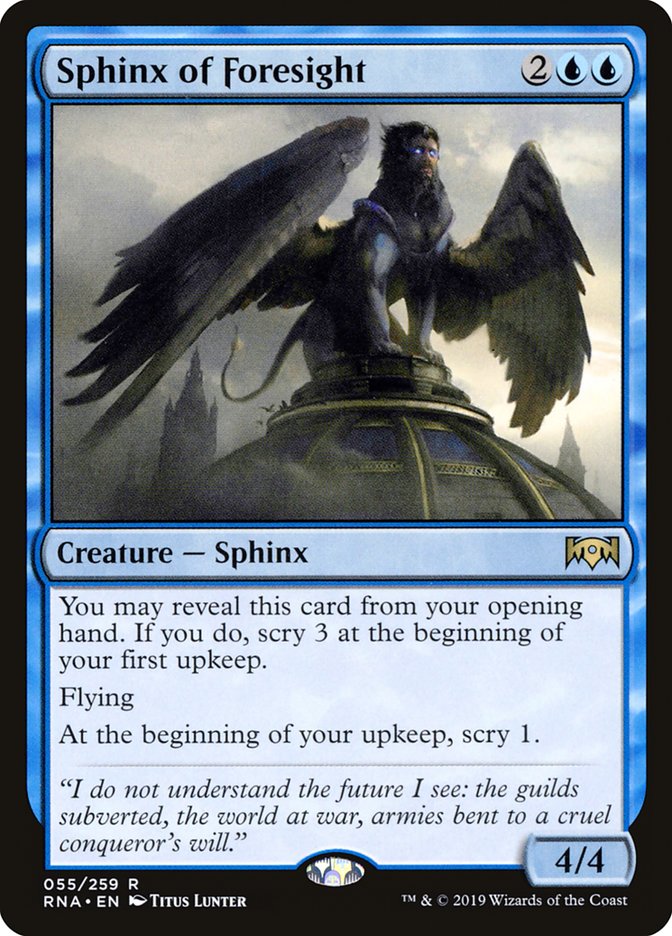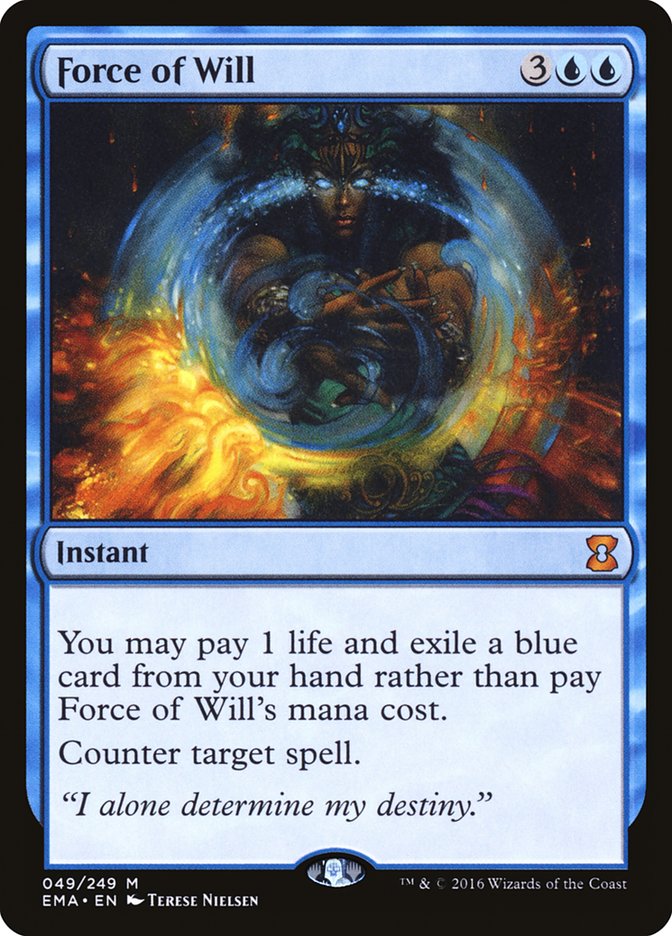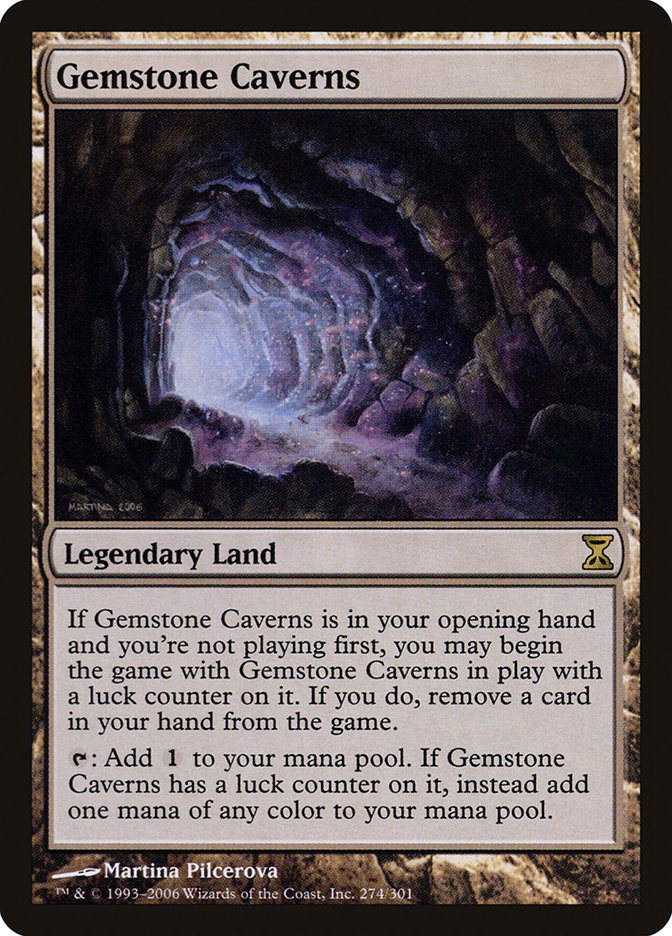Reveal Chancellor of the Annex. Swamp, Dark Ritual, Entomb for
Griselbrand, Animate Dead. Oh, you had a Force of Will? Sorry. Draw
fourteen, good game.
One of my biggest eye-rolling moments in Magic is when an opponent gets to
start the game with a powerful, free effect that dramatically constrains my
options in the first few turns. The three biggest offenders, historically,
have been Leyline of the Void, Leyline of Sanctity, and Chancellor of the
Annex. These cards absolutely demolish opposing strategies when they’re in
exactly the top seven cards of the library, but there’s a notable drawback
to these ham-fisted hate cards. If drawn in the next seven cards,
they are truly embarrassing. Without a way to filter away these midgame
monstrosities, I’m always worried about the chance of drawing one in the
middle turns and falling behind because of it. These powerful free effects
are often held back because they obviously break the game if they’re too
good. The few with unique sideboard potential are stellar, but it seems
like they’ve only ever been designed to have a binary outcome.
And I hate, hate, hate cards that only offer a binary outcome of
“game-winning” or “total brick.” It’s one of the reasons I generally loathe
playing Leyline of the Void in Grixis Death’s Shadow, which teaches
valuable lessons about low-resource games and opportunity costs of drawing
cards with no text during the game. Leylines, like Goblin Guides and Urza’s
lands, are the kind of cards that I rarely play and often lose to. What can
I say? I can’t take the polarizing nature of these “opening hand matters”
cards.
Sphinx of Foresight changes all that wisdom. Sphinx of Foresight offers a
beneficial, but not game-winning ability in your opening hand, alongside a
respectable 4/4 flying body with Thassa, God of the Sea’s most underrated
ability attached. This is unprecedented and will require a re-evaluation of
several important heuristics we use to determine both mulligan and
deckbuilding decisions.
Right off the bat, Sphinx of Foresight immediately screams “best card in
the set for Limited play” to those who recognize the impact of basically
never having to mulligan a hand with this card. Of course, 4/4 flying
creatures that prevent you from drawing more unneeded lands in the midgame
are also incredible in Limited. Even more impressive is the fact that if
Sphinx is in your opening hand, the scry 3 effect means you are highly
likely to curve out properly into dropping this powerhouse on turn 4, and
any way to reduce the inherent fail rate in most Limited decks is an
extremely welcome development. I’ll be first picking this in every draft,
and I’ll lean towards drafting blue in Ravnica Allegiance Draft
just in case I open the Sphinx in pack 2 or 3.
It’s that good.
But the implications are far subtler in Constructed, where the scry 3
ability impacts not only mulligan decisions but also offers a way for
linear decks like Dredge to more consistently assemble their engine or find
their answer to hate cards in the sideboard games. A full-blown four-color
Dredge deck with City of Brass and Mana Confluence would even be able to
cast Prized Amalgam and Sphinx of Foresight to fight fair in sideboard
games against heavily diluted opposing strategies, and the Sphinx’s card
selection offers a powerful way to dig quickly for relevant answers like
Nature’s Claim or Abrupt Decay.
Creatures (18)
Lands (19)
Spells (23)

But trying to stitch together a semi-fair gameplan on top of a linear
strategy isn’t necessarily the best way to use Sphinx of Foresight, though
it is an exciting line of thinking to follow.
No, I’d like to see Sphinx of Foresight used in (what else?) low-land-count
blue decks with a cantrip suite and a desire to avoid flooding out in the
midgame.
I’d like to play seventeen-land Standard decks with Sphinx of Foresight to
act as a pseudo-Preordain in the opening hand. I’d like to try a
sixteen-land Legacy deck with Sphinx of Foresight to pitch to Force of Will
or get Brainstormed away if needed while also offering a creature that owns
the sky in a world of Insectile Aberration and Vendilion Clique. I’m
already getting heated thinking about how I can fit Sphinx of Foresight in
Izzet Phoenix or Grixis Death’s Shadow in Modern.
What people aren’t quite wrapping their heads around with Sphinx of
Foresight is that it’s another way for us to cut a land or two from stock
blue cantrip decks and barely feel the pinch. This card is a playable way
to hedge against mana flood in the right strategies. And if there’s one
thing I know how to do, it’s cut a land from stock decks and win with them.
Whether it was nineteen lands and Traverse the Ulvenwald in Four-Color
Saheeli, or cutting the eighteenth land from previously maligned “bad,
flood-prone Grixis Death’s Shadow” by adding a zero-mana Opt in Mishra’s
Bauble, or playing nineteen lands and Search for Azcanta to enable
Niv-Mizzet, Parun in Izzet Phoenix at the Pro Tour, cutting a land has
become a specialty of mine; and I expect Sphinx of Foresight is going to
catch quite a few people off-guard in furthering the viability of this line
of thinking.
Creatures (13)
Lands (16)
Spells (31)

One of the other unexpected bonuses of a card with such a potent card
selection effect on the first turn of the game is an increase in the impact
and virtual density of, you guessed it, sideboard cards. Rather than
praying for a Leyline of the Void to be in your opening hand, a Sphinx of
Foresight allows a hypothetical Azorius Midrange deck to dig deeply to try
and find a Rest in Peace in Modern against Dredge, or a Legacy Grixis
Control deck to find its Diabolic Edict against Turbo Depths. In Modern and
Legacy, particularly, the impact of sideboard cards can’t be overstated,
and I expect the combination of a scry 1 from a mulligan in concert with
the scry 3 from Sphinx of Foresight to lead to a significantly higher
percentage of sideboard games against linear decks with the appropriate
hate cards.
Oh, and by the way, Sphinx of Foresight is a four-power creature. Stubborn
Denial, anybody? Plus, on the play it works wonders with Street Wraith,
creating basically a super-Preordain for zero mana. Seems like a match made
in heaven with some of my favorite cards, no?
Creatures (18)
Lands (16)
Spells (26)

It’s not only the older formats where Sphinx’s card selection impact will
change the dynamic against linear decks. Now Jeskai Drakes will be able to
consistently find a sideboard Deafening Clarion to fight aggro. And yes,
reading between the lines, I do fully expect that Deafening Clarion and
Sphinx of Foresight are going to be quite good together. With improved mana
from Hallowed Fountain, Jeskai Drakes will be quite a force in upcoming
Standard. Four-toughness, flying monsters and a sweeper that also gains
back huge chunks of life is a combo long overdue for center stage in
Standard.
The only unfortunate conflict with Sphinx of Foresight in such a deck is
the clogged four-mana slot on the mana curve, competing with Crackling
Drake for the role of game-ending finisher. The fact that I’m not
completely sold on which flying creature is better in such a deck is reason
enough to respect the Sphinx. Should a Sultai or Simic deck arrive to
compete with Azorius, Izzet, or Jeskai, though, expect Sphinx of Foresight
to be a huge part of that deck’s success. And should a Jeskai or Azorius
Angels deck (a la Brad Nelson’s Boros Angels deck from just prior to the
Pro Tour at Grand Prix New Jersey) rise up in this new Standard, expect the
Sphinx to be a large player in smoothing out the draws of an
often-disjointed midrange deck to better compete with control in
post-sideboard games.
Creatures (22)
- 4 Tocatli Honor Guard
- 4 Adanto Vanguard
- 4 Rekindling Phoenix
- 3 Lyra Dawnbringer
- 4 Resplendent Angel
- 3 Aurelia, Exemplar of Justice
Lands (25)
Spells (13)

Clearly, Sphinx of Foresight has a powerful consistency-improving effect in
opening hands while offering a reasonable rate for a game-ending creature
alone. There’s one small point that remains somewhat understated, though,
one which may be of some interest to players who are willing to experiment
a bit with various sacred cows of Magic theory.
Sphinx of Foresight, unlike the Leylines before it, offers a trigger upon
revealing it in the opening hand. This trigger occurs not during the first
upkeep of the game, but during your first upkeep of the game.
Being on the draw improves the effectiveness of such a trigger by quite a
significant margin. Knowing what you are up against informs what you’ll be
looking to do on the first turn of the game. How many times have you
mulliganed an opening hand, looked at a Fatal Push on top of your deck,
and not known whether you even wanted the card against an unknown matchup?
We must revert to live reads of our opponents or looking up an opponent’s
MTGO screenname to try to figure out what deck they might be on to help
make this annoying decision. With Sphinx of Foresight, this problem will
only get worse, but on the draw, suddenly Sphinx of Foresight looks an
awful lot like a zero-mana super-Preordain to find whatever piece of
interaction is necessary that turn.
Adding fetchlands in Modern and Legacy into the equation, and perhaps
losing the die roll won’t sting quite so hard anymore. Fetching away your
carefully scryed top three cards in order to facilitate casting a turn 1
Thoughtseize or Lightning Bolt is a unique disappointment.
Super-Preordaining on the draw for that turn-1 discard spell, removal
spell, or necessary land is equally thrilling, and I applaud Wizards of the
Coast for designing a card that reduces the feel-bad of losing the die roll
in such an elegant way. Forget Gemstone Caverns (though I do suspect that
it is underplayed relative to its power level, but that’s a discussion for
a different day). Sphinx of Foresight is upgraded on the draw to a point
where I’m not confident that being on the play with certain decks in
certain formats against certain matchups is necessarily correct. And
anything that adds more balance to the inherently random factors in a game
of Magic is a good place to experiment, so bravo to WotC for creating that
small bit of tension to spice up this potent card.
Sphinx of Foresight may not look like it on first glance, but the card
offers a lot for the decks that are able to make use of both halves. I’m
excited to push the boundaries of conventional Magic wisdom with this.


